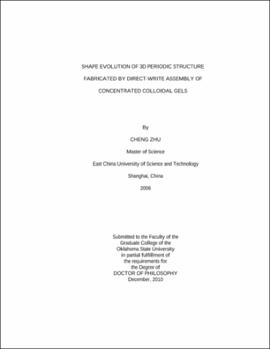| dc.contributor.advisor | Smay, James E. | |
| dc.contributor.author | Zhu, Cheng | |
| dc.date.accessioned | 2013-11-26T08:31:44Z | |
| dc.date.available | 2013-11-26T08:31:44Z | |
| dc.date.issued | 2010-12 | |
| dc.identifier.uri | https://hdl.handle.net/11244/7176 | |
| dc.description.abstract | Scope and Method of Study: 3D periodic structures were fabricated by direct-write assembly of concentrated colloidal gels with self-supporting features. The rheological behavior of the gel was characterized in linear viscoelastic regions. The flow behavior of the gel was modeled by using structural kinetics theory. Based on this model, the dynamic extrusion process of the gel was simulated by incorporating slip wall boundary conditions. A viscoelastic catenary model was developed to describe span shape and compare the results to previous results that used a simple elastic beam theory. The shape evolution (i.e., spanning behavior) of spanning filaments observed was related to shear stress conditions and a limited set of rheological parameters. | |
| dc.description.abstract | Findings and Conclusions: The rate and magnitude of microstructure change within a colloidal gel ink are crucial factors for shape evolution of 3D structures assembled by direct write techniques. The events that set the equilibrium shape of 3D structure occur within the initial few seconds after deposition and gels microstructure recovery within this period is critical to geometric fidelity. The shape evolution of 3D structures may be predicted by knowledge of the rheological behavior of the colloidal gel in shear loading. Rheological behavior can be related to the structural recovery time of the colloidal gel and this may be measured with a series of equilibrium flow measurements. Successful completion of this research advances science-based ink design methods and optimization of deposition variables. Better control of shape evolution will lead to improvements in advanced applications such as photonic band gap structures, artificial bone structures, and metal-ceramic composites. The improved connections between time-dependent shear behavior and shape evolution in an extrusion process will also impact other industries (e.g., clay extrusion for catalytic converter substrates) and improve industrial productivity through better paste design. Although the current work is limited to colloidal gels, the knowledge gained here may be easily extended to other complex ink systems such as partially melted thermoplastic polymers and metals. | |
| dc.format | application/pdf | |
| dc.language | en_US | |
| dc.rights | Copyright is held by the author who has granted the Oklahoma State University Library the non-exclusive right to share this material in its institutional repository. Contact Digital Library Services at lib-dls@okstate.edu or 405-744-9161 for the permission policy on the use, reproduction or distribution of this material. | |
| dc.title | Shape evolution of 3D periodic structure fabricated by direct-write assembly of concentrated colloidal gels | |
| dc.contributor.committeeMember | Johannes, A. J. | |
| dc.contributor.committeeMember | High, Martin S. | |
| dc.contributor.committeeMember | Ford, Warren T. | |
| osu.filename | Zhu_okstate_0664D_11113.pdf | |
| osu.accesstype | Open Access | |
| dc.type.genre | Dissertation | |
| dc.type.material | Text | |
| thesis.degree.discipline | Chemical Engineering | |
| thesis.degree.grantor | Oklahoma State University | |
